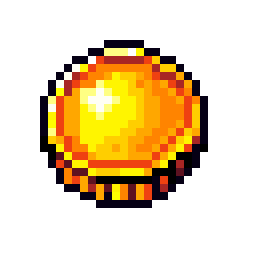Retro Game Weapon Icons: Teal, Orange & Blue Palette
A collection of eight pixel art firearms are displayed as inventory icons against a black background, possibly from a retro-futuristic game. The weapons, rendered in muted orange-brown and blue-grey, are presented in a grid-like arrangement below a dark teal banner with blurred text.
Read More
The pixel art image displays a collection of eight distinct, horizontally oriented weapon sprites, likely firearms, against a stark black background. Above these sprites, a section of blurred or pixelated text is present within a dark teal banner. Each weapon is depicted in a static, side-on view, showcasing its general silhouette and a few key components like barrels, stocks, and magazines. There is no implied action or movement; they are presented as inventory icons or collectible items.
The composition places the weapon sprites in two vertical columns of four, evenly spaced across the lower two-thirds of the image. This grid-like arrangement suggests a display or selection screen. The dark teal banner occupies the top fifth of the frame, with the indistinct text centered within it, acting as a title or description area for the items below. The background is a uniform, absolute black, providing high contrast that makes the weapon sprites and the banner stand out prominently.
The dominant colors in the image are a deep, muted teal (for the banner and some weapon components), various shades of a warm, rusty orange-brown (primarily for the weapon bodies and stocks), and a dark, desaturated blue-grey (for other weapon components, creating a metallic impression). A few lighter teal-blue pixels are scattered among the darker blue-grey areas, hinting at reflections or highlights. The overall color scheme is muted and industrial, relying on a complementary contrast between the warm orange-browns and the cool blue-greys and dark teal.
The overall vibe is functional and somewhat utilitarian, typical of game asset displays. It evokes a sense of inventory management or a crafting interface in a video game, possibly in a retro-futuristic or post-apocalyptic setting given the weapon designs and color palette. The pixelation contributes to a nostalgic, retro gaming aesthetic. The blurred text at the top, along with the consistent presentation of the weapon sprites, reinforces the impression of a UI element rather than a standalone artistic scene. No other distinct details or UI elements are visible beyond the blurred text and the weapon sprites themselves.
 0
0
